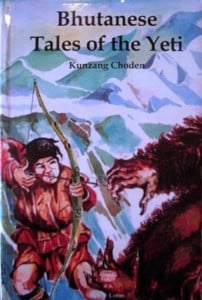
By Kunzang Choden
As fictional as the yeti may seem to a westerner, to the Bhutanese it still exists.
Known as the migyo in Bhutan, the Bhutanese believe that sighting one is inauspicious. During a recent trek to the northern highlands, I was advised by yak herders that I run downhill should I spot a female yeti. They probably assumed I would know the difference between a male and a female. Well, you know what they say about assumptions?
“Female yetis have huge sagging breasts and, therefore, cannot run downhill,” one yak herder clarified, much to my relief.
I suddenly felt confident I could tell the difference between a male and a female, if I did run into one that is, just by looking at its chest.
Jokes apart, there is a dedicated yeti national park in the eastern most corner of Bhutan. Spanning an area of 650 sq km, the Sakteng Wildlife Sanctuary is also known as the Migyo National Park. There have been surveys carried out to determine the existence of the yeti but so far none have been spotted.
In Bhutan, till date, there have been three expeditions to spot the animal that is known to leave behind giant footprints in the snow. The first expedition was undertaken by Reinhold Messner in the summer of 1987. He travelled deep into the Bhutanese Himalayas with a small group of friends. His travel far and wide did not culminate in any sightings of the abominable snowman, but, he did, however, bring out a book of his adventure titled – My Quest for the yeti.
Still convinced that the yeti roamed the Himalayas, Messner returned to Bhutan in 1991. This time, he got along German television host Tina Radke, cameraman Fulvio Mariani and photographer Paul Hanny. They too traversed the length and breadth of the country. And one such path led them to Phobjika Valley.
Inside the Gangtay Monastery in Phobjika, a young lama brought a key and the door to the tantric chamber was opened. There, nailed to the wall was the hide of a humongous animal with bones still attached to it. Its head was mostly bald except for a long, black hank of hair that was dangling from the rear.
Messner asked the monk what creature the hide belonged to and the young lama replied that it belonged to a yeti cub that had been killed some 400 years ago. The team was not permitted to take any photographs and so they returned home perhaps even more convinced or confused – who can say!
The third expedition took place in 2001 when the Bhutanese government granted a British television producer – Harry Marshall, permission to film his search for the yeti.
Marshall’s trip resulted in a popular television program titled To the end of the earth: In search of the Wildman. It was aired on Channel Four in the United Kingdom.
Marshall and his team, during their expedition, had found hair samples on a tree bark that they took back to England. The samples were examined and studied by DNA scientists led by Molecular scientist Brian Syked from Oxford University. Surprisingly, the result didn’t indicate a match to any living species found on earth. The findings created a lot of excitement in the western world and the DNA results renewed the faith in the existence of the yeti.
Every now and then, giant footsteps are often spotted by the wayward traveler in Bhutan. And people in the high mountains believe that the male and female yeti meet only once a year to mate. But, whether it’s just a myth or an elusive reality, the fact is that the belief in the existence of the yeti persists. Therefore, the search will not end, now or ever.

